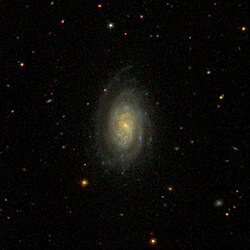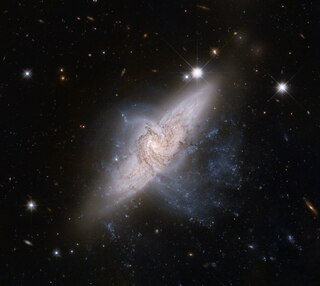
NGC 3314 is a pair of overlapping spiral galaxies between 117 and 140 million light-years away in the constellation Hydra. This unique alignment gives astronomers the opportunity to measure the properties of interstellar dust in the face-on foreground galaxy. The dust appears dark against the background galaxy. Unlike interacting galaxies, the two components of NGC 3314 are physically unrelated. It was discovered in April 1999.

NGC 1316 is a lenticular galaxy about 60 million light-years away in the constellation Fornax. It is a radio galaxy and at 1400 MHz is the fourth-brightest radio source in the sky.

NGC 1931 is an emission and reflection nebula in the constellation Auriga. The nebula has been referred to as a "miniature version of the Orion Nebula", as it shares some of the same characteristics. It is a mixed emission-reflection nebula, and contains a smaller version of the Trapezium in its hot young star cluster centered in the emission nebula. The entire cluster/nebula complex is only about 3 arcmin in size. The distance from earth is estimated at about 7000 light years.

NGC 1023 is a barred lenticular galaxy, a member of the NGC 1023 group of galaxies in the Local Supercluster. Distance measurements vary from 9.3 to 19.7 million parsecs (30 to 64 million light-years). The supermassive black hole at the core has a mass of (4.4±0.5)×107 M☉. The black hole was discovered by analyzing the dynamics of the galaxy.

NGC 227 is a lenticular galaxy located approximately 237 million light-years from the Sun in the constellation Cetus. It was discovered on October 1, 1785 by William Herschel.

NGC 299 is an open cluster of stars in the main body of the Small Magellanic Cloud – a nearby dwarf galaxy. It is located in the southern constellation of Tucana, just under 200,000 light years distant from the Sun. The cluster was discovered on August 12, 1834 by English astronomer John Herschel.
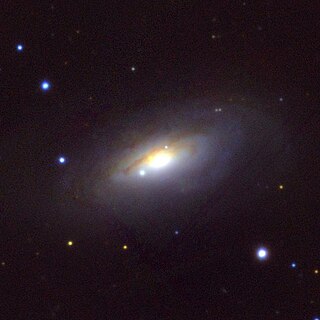
NGC 3285 is a barred spiral galaxy located about 200 million light-years away in the constellation Hydra. The galaxy was discovered by astronomer John Herschel on March 24, 1835. NGC 3285 is a member of the Hydra Cluster.

NGC 3305 is an elliptical galaxy located about 190 million light-years away in the constellation Hydra. The galaxy was discovered by astronomer John Herschel on March 24, 1835. NGC 3305 is a member of the Hydra Cluster.

NGC 3307 is a lenticular galaxy located about 185 million light-years away in the constellation Hydra. The galaxy was discovered by astronomer John Herschel on March 22, 1836 and is a member of the Hydra Cluster.
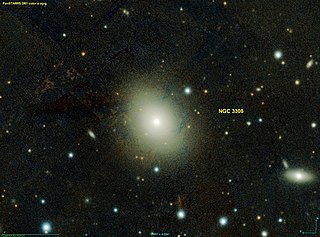
NGC 3308 is a lenticular galaxy with a faint bar located about 174 million light-years away in the constellation Hydra. NGC 3308 was discovered by astronomer John Herschel on March 24, 1835. It is a member of the Hydra Cluster.
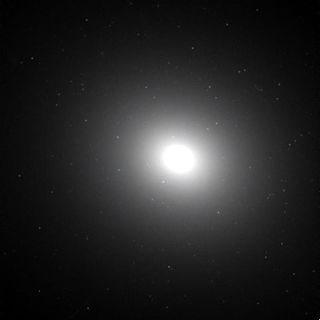
NGC 3309 is a giant elliptical galaxy located about 200 million light-years away in the constellation Hydra. NGC 3309 was discovered by astronomer John Herschel on March 24, 1835. The galaxy forms a pair with NGC 3311 which lies about 72,000 ly (22 kpc) away. Both galaxies dominate the center of the Hydra Cluster.

NGC 3312 is a large and highly inclined spiral galaxy located about 194 million light-years away in the constellation Hydra. The galaxy was discovered by astronomer John Herschel on March 26, 1835. It was later rediscovered by astronomer Guillaume Bigourdan on February 26, 1887. NGC 3312 was later listed and equated with IC 629 because the two objects share essentially the same celestial coordinates. NGC 3312 is the largest spiral galaxy in the Hydra Cluster and is also classified as a LINER galaxy.

NGC 3313 is a large barred spiral galaxy located about 55 megaparsecs away in the constellation Hydra. It was discovered by astronomer Ormond Stone in 1886 and is an outlying member of the Hydra Cluster.

NGC 3315 is a lenticular galaxy located about 185 million light-years away in the constellation Hydra. It was discovered by astronomer Edward Austin on March 24, 1870. It is a member of the Hydra Cluster.
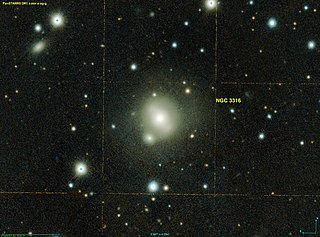
NGC 3316 is a barred lenticular galaxy located about 190 million light-years away in the constellation Hydra. The galaxy was discovered by astronomer John Herschel on March 26, 1835. NGC 3316 is a member of the Hydra Cluster, and appears to have a small companion galaxy known as HCC 15.
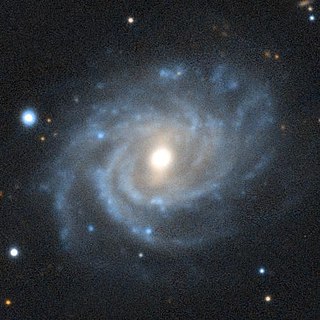
NGC 3336 is a barred spiral galaxy located about 190 million light-years away in the constellation Hydra. It was discovered by astronomer John Herschel on March 24, 1835. NGC 3336 is a member of the Hydra Cluster.

NGC 3369 is a lenticular galaxy located about 175 million light-years away in the constellation Hydra. NGC 3369 was discovered by astronomer Ormond Stone in 1886 and is an outlying member of the Hydra Cluster.
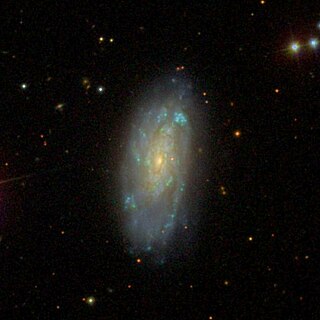
NGC 7448 is a spiral galaxy located in the constellation Pegasus. It is located at a distance of circa 80 million light years from Earth, which, given its apparent dimensions, means that NGC 7448 is about 60,000 light years across. It was discovered by William Herschel on October 16, 1784. It is included in the Atlas of Peculiar Galaxies in the category galaxies with detached segments.

NGC 7418 is an intermediate spiral galaxy located in the constellation Grus. It is located at a distance of circa 60 million light-years from Earth, which, given its apparent dimensions, means that NGC 7418 is about 60,000 light-years across. It was discovered by John Herschel on August 30, 1834.

NGC 5363 is a lenticular galaxy located in the constellation Virgo. It is located at a distance of circa 65 million light years from Earth, which, given its apparent dimensions, means that NGC 5363 is about 100,000 light years across. It was discovered by William Herschel on January 19, 1784. It is a member of the NGC 5364 Group of galaxies, itself one of the Virgo III Groups strung out to the east of the Virgo Supercluster of galaxies.
